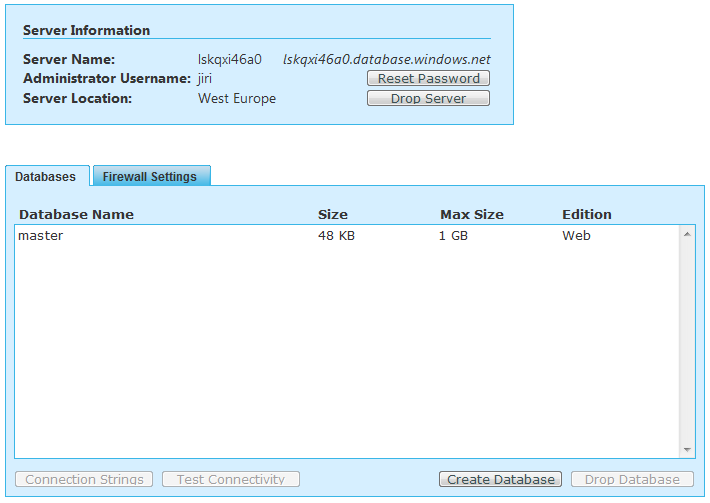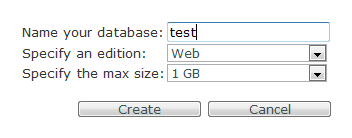SQL Azure and Entity Framework
From time to time I get a question about SQL Azure and Entity Framework. Can I use it? Does it work? Etc. Because the SQL Azure is in fact a special version (you can check unsupported and partially supported T-SQL statements) of MS SQL Server it works without any hassle. That’s the short story.
The following lines will quickly guide you through the steps of using SQL Azure with Entity Framework. You need to have and Azure account ready. There’s no way to install SQL Azure to your own server or something like that. First login in to sql.azure.com and select some project you have there. This will bring you this screen.

By default only master database is created and it’s up to you to create additional database. Right now you can create from two editions and few sizes: Web and Business and from 1GB to 50GB. The price you’ll pay depends on this selection (but not only). For purpose of this article I created 1GB Web edition database.

On the main screen you have a button to get a connection string. I’m often using it, as it’s easier for me to get information from it than compose it from pieces on screen. 😃 Mine is:
Data Source=lskqxi46a0.database.windows.net;Initial Catalog=test;Persist Security Info=True;User ID=jiri@lskqxi46a0;Password=******;MultipleActiveResultSets=True;Encrypt=True
After these initial steps we can start using the database. Because I was too lazy to create tables and so on manually I tested one feature of Entity Framework I’m not much familiar with. It’s Model First. You simply create the conceptual model and later generate SQL script from it for your database (yes, Firebird has support too 😉). I created basic “blogging system” model. Author has many Posts. Posts have many Tags. Right clicking on model and selecting Generate database from model resulted in my case in simple script.
-- --------------------------------------------------
-- Entity Designer DDL Script for SQL Server 2005, 2008, and Azure
-- --------------------------------------------------
-- Date Created: 01/29/2011 16:40:18
-- Generated from EDMX file: C:\Users\Jiri\Desktop\ConsoleApplication3\ConsoleApplication3\Model1.edmx
-- --------------------------------------------------
SET QUOTED_IDENTIFIER OFF;
GO
USE [test];
GO
IF SCHEMA_ID(N'dbo') IS NULL EXECUTE(N'CREATE SCHEMA [dbo]');
GO
-- --------------------------------------------------
-- Dropping existing FOREIGN KEY constraints
-- --------------------------------------------------
IF OBJECT_ID(N'[dbo].[FK_BlogPostTag_BlogPost]', 'F') IS NOT NULL
ALTER TABLE [dbo].[BlogPostTag] DROP CONSTRAINT [FK_BlogPostTag_BlogPost];
GO
IF OBJECT_ID(N'[dbo].[FK_BlogPostTag_Tag]', 'F') IS NOT NULL
ALTER TABLE [dbo].[BlogPostTag] DROP CONSTRAINT [FK_BlogPostTag_Tag];
GO
IF OBJECT_ID(N'[dbo].[FK_BlogPostAuthor]', 'F') IS NOT NULL
ALTER TABLE [dbo].[BlogPosts] DROP CONSTRAINT [FK_BlogPostAuthor];
GO
-- --------------------------------------------------
-- Dropping existing tables
-- --------------------------------------------------
IF OBJECT_ID(N'[dbo].[BlogPosts]', 'U') IS NOT NULL
DROP TABLE [dbo].[BlogPosts];
GO
IF OBJECT_ID(N'[dbo].[Authors]', 'U') IS NOT NULL
DROP TABLE [dbo].[Authors];
GO
IF OBJECT_ID(N'[dbo].[Tags]', 'U') IS NOT NULL
DROP TABLE [dbo].[Tags];
GO
IF OBJECT_ID(N'[dbo].[BlogPostTag]', 'U') IS NOT NULL
DROP TABLE [dbo].[BlogPostTag];
GO
-- --------------------------------------------------
-- Creating all tables
-- --------------------------------------------------
-- Creating table 'BlogPosts'
CREATE TABLE [dbo].[BlogPosts] (
[ID] int IDENTITY(1,1) NOT NULL,
[Created] datetime NOT NULL,
[Heading] nvarchar(max) NOT NULL,
[Content] nvarchar(max) NOT NULL,
[Author_ID] int NOT NULL
);
GO
-- Creating table 'Authors'
CREATE TABLE [dbo].[Authors] (
[ID] int IDENTITY(1,1) NOT NULL,
[Name_FirstName] nvarchar(max) NOT NULL,
[Name_LastName] nvarchar(max) NOT NULL,
[LastLoggedIn] datetime NOT NULL
);
GO
-- Creating table 'Tags'
CREATE TABLE [dbo].[Tags] (
[ID] int IDENTITY(1,1) NOT NULL,
[Name] nvarchar(max) NOT NULL
);
GO
-- Creating table 'BlogPostTag'
CREATE TABLE [dbo].[BlogPostTag] (
[BlogPosts_ID] int NOT NULL,
[Tags_ID] int NOT NULL
);
GO
-- --------------------------------------------------
-- Creating all PRIMARY KEY constraints
-- --------------------------------------------------
-- Creating primary key on [ID] in table 'BlogPosts'
ALTER TABLE [dbo].[BlogPosts]
ADD CONSTRAINT [PK_BlogPosts]
PRIMARY KEY CLUSTERED ([ID] ASC);
GO
-- Creating primary key on [ID] in table 'Authors'
ALTER TABLE [dbo].[Authors]
ADD CONSTRAINT [PK_Authors]
PRIMARY KEY CLUSTERED ([ID] ASC);
GO
-- Creating primary key on [ID] in table 'Tags'
ALTER TABLE [dbo].[Tags]
ADD CONSTRAINT [PK_Tags]
PRIMARY KEY CLUSTERED ([ID] ASC);
GO
-- Creating primary key on [BlogPosts_ID], [Tags_ID] in table 'BlogPostTag'
ALTER TABLE [dbo].[BlogPostTag]
ADD CONSTRAINT [PK_BlogPostTag]
PRIMARY KEY NONCLUSTERED ([BlogPosts_ID], [Tags_ID] ASC);
GO
-- --------------------------------------------------
-- Creating all FOREIGN KEY constraints
-- --------------------------------------------------
-- Creating foreign key on [BlogPosts_ID] in table 'BlogPostTag'
ALTER TABLE [dbo].[BlogPostTag]
ADD CONSTRAINT [FK_BlogPostTag_BlogPost]
FOREIGN KEY ([BlogPosts_ID])
REFERENCES [dbo].[BlogPosts]
([ID])
ON DELETE NO ACTION ON UPDATE NO ACTION;
GO
-- Creating foreign key on [Tags_ID] in table 'BlogPostTag'
ALTER TABLE [dbo].[BlogPostTag]
ADD CONSTRAINT [FK_BlogPostTag_Tag]
FOREIGN KEY ([Tags_ID])
REFERENCES [dbo].[Tags]
([ID])
ON DELETE NO ACTION ON UPDATE NO ACTION;
-- Creating non-clustered index for FOREIGN KEY 'FK_BlogPostTag_Tag'
CREATE INDEX [IX_FK_BlogPostTag_Tag]
ON [dbo].[BlogPostTag]
([Tags_ID]);
GO
-- Creating foreign key on [Author_ID] in table 'BlogPosts'
ALTER TABLE [dbo].[BlogPosts]
ADD CONSTRAINT [FK_BlogPostAuthor]
FOREIGN KEY ([Author_ID])
REFERENCES [dbo].[Authors]
([ID])
ON DELETE NO ACTION ON UPDATE NO ACTION;
-- Creating non-clustered index for FOREIGN KEY 'FK_BlogPostAuthor'
CREATE INDEX [IX_FK_BlogPostAuthor]
ON [dbo].[BlogPosts]
([Author_ID]);
GO
-- --------------------------------------------------
-- Script has ended
-- --------------------------------------------------
Now we can finally write some code to let Entity Framework do some dirty job. Let’s create some authors and issue a non-trivial query to see what’s what.
using (Model1Container ctx = new Model1Container())
{
Author a1 = new Author();
a1.Name.FirstName = "Foo";
a1.Name.LastName = "Bar";
a1.LastLoggedIn = DateTime.Now;
Author a2 = new Author();
a2.Name.FirstName = "Jiri";
a2.Name.LastName = "Cincura";
a2.LastLoggedIn = DateTime.Now;
ctx.Authors.AddObject(a1);
ctx.Authors.AddObject(a2);
ctx.SaveChanges();
Debug.Assert(a1.ID != default(int));
Debug.Assert(a2.ID != default(int));
var blogPosts = ctx.Authors
.Where(a => a.Name.LastName == "Cincura")
.SelectMany(a => a.BlogPosts)
.Where(bp => bp.Tags.Any(t => t.Name == "Databases" || t.Name == "Azure" || t.Name == "Cloud"))
.Select(bp => new { bp.Heading, bp.Created });
Console.WriteLine((blogPosts as ObjectQuery).ToTraceString());
foreach (var blogPost in blogPosts)
{
Console.WriteLine(blogPost.Heading);
}
}
Surprise. Nothing bloodthirsty. 😎 It works as expected. Two authors are created. You can check that by querying the table or by looking at database size at sql.azure.com. The query itself is standard T-SQL query you can run on MS SQL Server as well, nothing magic.
SELECT
[Extent1].[ID] AS [ID],
[Extent2].[Heading] AS [Heading],
[Extent2].[Created] AS [Created]
FROM [dbo].[Authors] AS [Extent1]
INNER JOIN [dbo].[BlogPosts] AS [Extent2] ON [Extent1].[ID] = [Extent2].[Author_ID]
WHERE (N'Cincura' = [Extent1].[Name_LastName]) AND ( EXISTS (SELECT
1 AS [C1]
FROM [dbo].[BlogPostTag] AS [Extent3]
INNER JOIN [dbo].[Tags] AS [Extent4] ON [Extent4].[ID] = [Extent3].[Tags_ID]
WHERE ([Extent2].[ID] = [Extent3].[BlogPosts_ID]) AND ([Extent4].[Name] IN (N'Databases',N'Azure',N'Cloud'))
))
Theory tells us, that if SQL Azure is more or less MS SQL Server database using more or less same wire protocol and more or less same T-SQL it should work. And it does. Here you have a small proof. Happy database-clouding.
